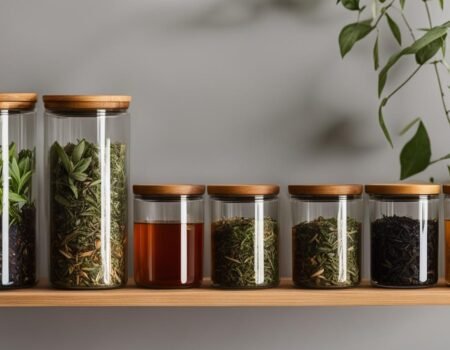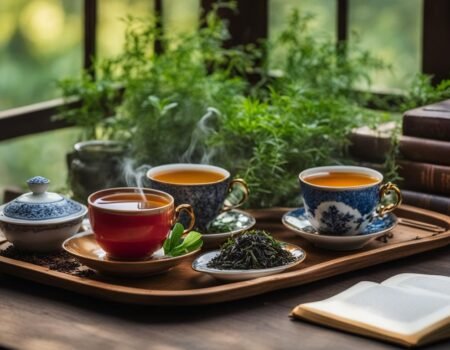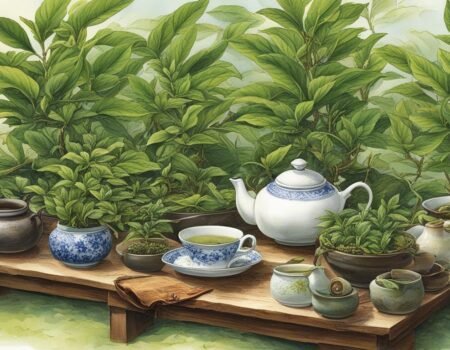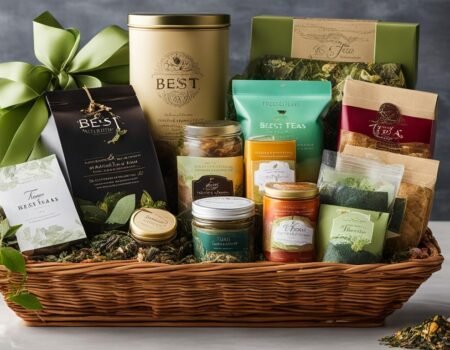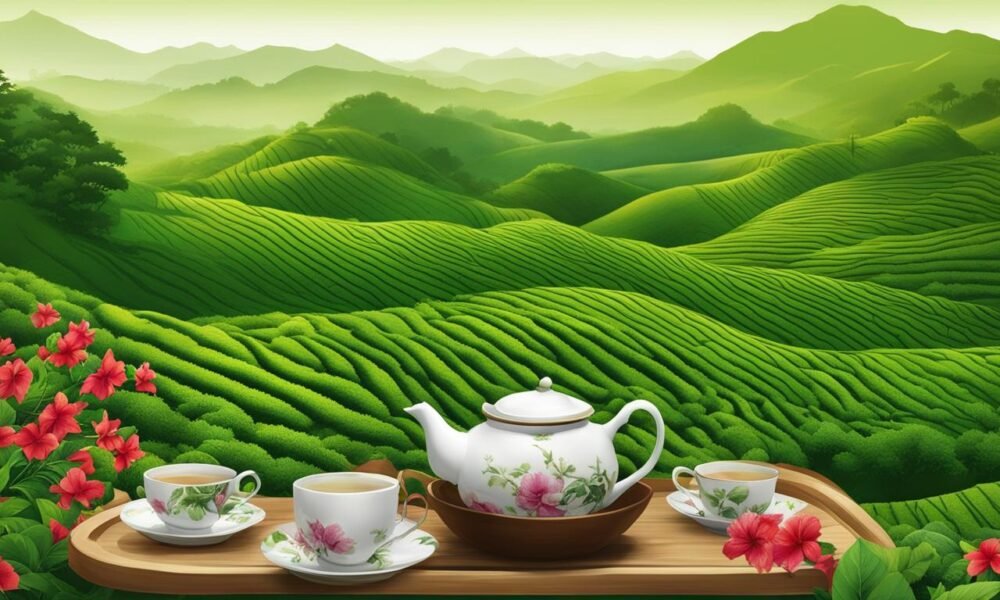
Discover the Different Types of Tea and Their Origins
Welcome to our exploration of the fascinating world of tea! Whether you’re a tea connoisseur or just beginning your tea journey, we invite you to join us as we uncover the different types of tea and their origins. From the robust flavors of black tea to the delicate nuances of white tea, each type of tea offers a unique experience that reflects its origin and processing methods.
As we dive into this aromatic and flavorful world, we’ll explore the primary types of tea, including black, green, white, oolong, pu-erh, purple, and herbal infusions. You’ll discover that all these teas originate from the same plant, Camellia sinensis, which has two varietals – camellia sinensis var. sinensis and camellia sinensis var. assamica. Each type of tea has its distinctive characteristics shaped by its harvesting and processing.
Key Takeaways:
- Tea is a diverse and richly nuanced beverage with a wide range of flavors.
- The main types of tea include black, green, white, oolong, pu-erh, purple, and herbal infusions.
- Black tea is robust, green tea is light, and white tea is delicate.
- Oolong tea falls between black and green teas in terms of oxidation.
- Pu-erh tea is aged and partially fermented, while purple tea is a relatively new variety.
Black Tea
Black tea is a popular and widely consumed type of tea known for its robust flavor and dark, coppery color. It is made through a specific process that involves harvesting tea leaves, wilting them, lightly crushing them, and fully oxidizing them. The oxidation process gives black tea its distinct flavor and aroma.
Black tea is primarily produced in China and India, with each region offering its unique varieties and flavors. Indian black teas are known for their strength, making them ideal for breakfast blends and bold tea beverages. On the other hand, Chinese black teas tend to be milder and enjoyed on their own, highlighting the natural taste and aroma of the tea leaves.
To fully appreciate the richness of black tea, it can be enjoyed plain or with a dash of milk and sugar. It provides a lovely balance between a robust taste and a caffeine boost, making it a popular choice for those looking for a flavorful and energizing beverage.
Black Tea Varieties
Black tea comes in various varieties, each with its unique characteristics and origins. Here are some popular types of black tea:
- Assam: Grown in the Assam region of India, Assam black tea is known for its strong and malty flavor.
- Darjeeling: Hailing from the Darjeeling region of India, Darjeeling black tea offers a delicate and floral taste.
- Keemun: Produced in China, Keemun black tea has a bold and smoky flavor, often compared to the taste of wine.
- Ceylon: From Sri Lanka, Ceylon black tea is known for its bright and citrusy notes.
Exploring the different types of black tea can be a delightful experience, allowing you to discover a world of flavors and aromas. Whether you prefer a strong cup of Assam or a delicate brew of Darjeeling, black tea offers a range of options to suit every tea lover’s palate.
| Black Tea Variety | Origin | Flavor Profile |
|---|---|---|
| Assam | India | Strong and malty |
| Darjeeling | India | Delicate and floral |
| Keemun | China | Bold and smoky |
| Ceylon | Sri Lanka | Bright and citrusy |
Green Tea
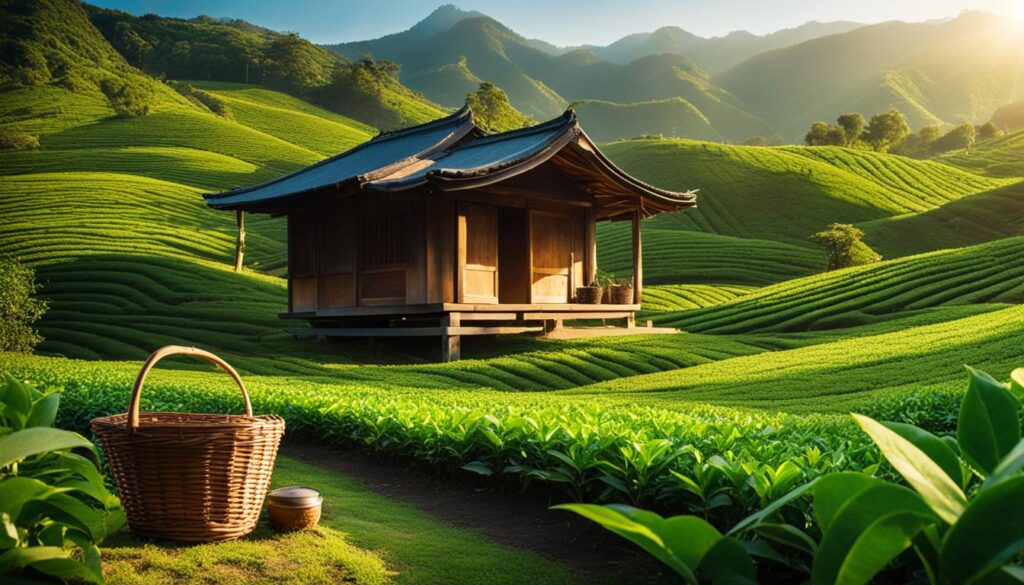
Green tea is a beloved and popular type of tea known for its refreshing flavor and numerous health benefits. It has a long history and originates from China, where it has been enjoyed for centuries. Today, green tea is also produced in Japan and other countries, each with its own unique variations in flavor and processing methods.
There are several different types of green tea, each with its own distinct characteristics. Some popular varieties include:
- Japanese Sencha: This is one of the most common types of green tea, known for its grassy, vegetal flavor.
- Chinese Dragon Well (Longjing): Dragon Well is a famous Chinese green tea with a smooth, nutty flavor.
- Matcha: Matcha is a finely ground green tea powder that is whisked into hot water, resulting in a vibrant green and intensely flavorful drink.
Green tea is made by harvesting the leaves of the Camellia sinensis plant and quickly heating them to prevent oxidation. The leaves are then rolled and dried, preserving their natural green color and fresh taste. This minimal processing gives green tea a lighter flavor compared to black tea, as well as a higher content of antioxidants.
Green Tea Benefits
Green tea is widely celebrated for its potential health benefits. It contains catechins, a type of antioxidant that may help protect against certain types of cancer and heart disease. Drinking green tea has also been linked to weight loss and improved brain function. Additionally, green tea is a natural source of caffeine, providing a gentle energy boost without the jitters often associated with coffee.
Overall, green tea is a versatile and enjoyable beverage that can be enjoyed hot or cold. Its refreshing taste and potential health benefits make it a popular choice for tea enthusiasts around the world.
White Tea: Delicate and Minimally Processed
White tea is a type of tea that is known for its delicate flavor and minimal processing. It is made from the young leaves and buds of the tea plant, which are carefully harvested and then air-dried with minimal processing. This gentle production process helps to preserve the natural flavors and aromas of the tea, resulting in a light and subtle taste.
White tea originated in China, particularly in the Fujian province, where it has been produced for centuries. The region’s unique climate and soil conditions contribute to the distinct characteristics of white tea. Today, white tea is also produced in other countries such as Nepal, Taiwan, and Sri Lanka, although Chinese white tea remains the most renowned.
| Types of White Tea | Flavors | Origins | Processing |
|---|---|---|---|
| Bai Hao Silver Needle | Delicate, sweet, and floral | Fujian province, China | Air-dried |
| Bai Mu Dan (White Peony) | Mild, subtly fruity, and floral | Fujian province, China | Air-dried |
| Shou Mei (Longevity Eyebrow) | Mellow, earthy, and slightly sweet | Fujian province, China | Air-dried |
| Gong Mei (Tribute Eyebrow) | Rich, earthy, and woody | Fujian province, China | Air-dried |
Overall, white tea offers a unique and refined tea-drinking experience. Its light and subtle flavors make it a perfect choice for those who prefer a milder taste profile. Whether you enjoy the delicate sweetness of Bai Hao Silver Needle or the earthy richness of Gong Mei, white tea is sure to delight your senses and provide a moment of tranquility in your day.
Oolong Tea: A Journey Through Flavors and Origins
Oolong tea is a fascinating tea variety that offers a unique taste experience. With its partially oxidized leaves, oolong tea falls between black and green teas in terms of oxidation, resulting in a wide range of flavors to explore. Let’s delve into the origins, flavors, and processing methods that make oolong tea a beloved choice among tea enthusiasts.
Oolong Tea Origins
Oolong tea has its roots in China and Taiwan, where it is primarily produced. Chinese oolong teas are known for their roasted flavors, providing a depth and complexity that captivates the palate. One famous region for Chinese oolongs is the Wuyi mountains, renowned for its heavily roasted oolongs. On the other hand, Taiwanese oolongs are more mellow and fragrant, with a wide range of flavors to discover.
Flavor Profiles of Oolong Tea
The flavor of oolong tea can vary greatly depending on the specific type and processing method. Lightly oxidized oolongs tend to have floral and fruity notes, while more heavily oxidized oolongs can showcase roasted, nutty flavors. Some oolongs have a sweet and creamy taste, reminiscent of milk or honey. It’s this incredible diversity of flavors that makes oolong tea a favorite among connoisseurs.
Processing Methods for Oolong Tea
The manufacturing process of oolong tea is intricate and requires skill and precision. After the leaves are harvested, they undergo a process that includes withering, wilting, and partial oxidation. The leaves are then shaped into tight twists or rolled balls, depending on the desired oolong type. Finally, they are dried to lock in the flavors and aromas. This careful processing results in the unique characteristics that oolong tea is known for.
If you’re looking to embark on a tea tasting adventure, oolong tea is a fantastic choice. With its rich flavors, diverse origins, and fascinating processing methods, oolong tea offers a truly remarkable tea-drinking experience. Explore the vast world of oolong teas and savor every sip of this enchanting beverage.
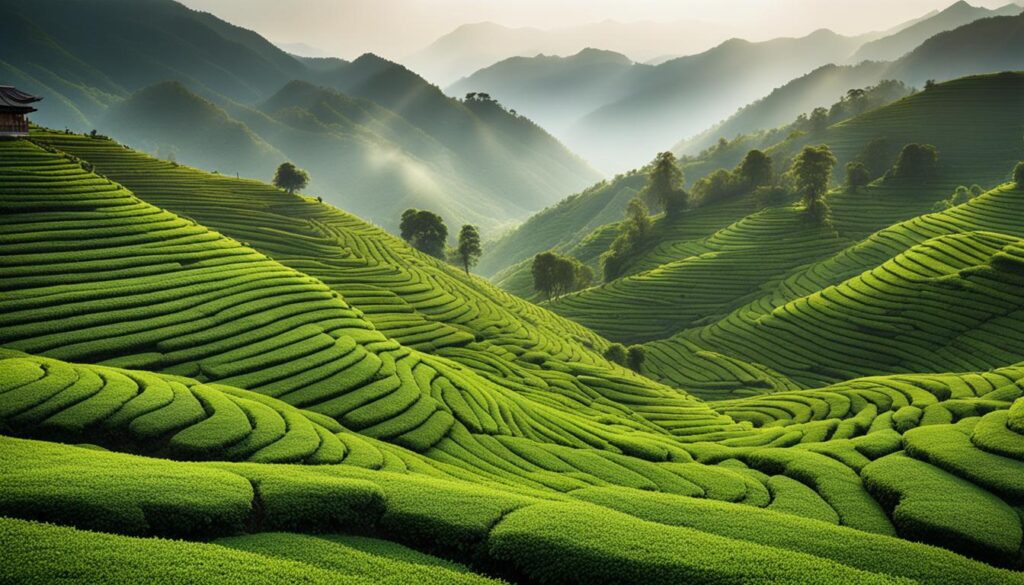
Pu-erh Tea: A Journey Through History and Flavor
Welcome to the fascinating world of Pu-erh tea, a unique and distinct type of tea with a rich history and complex flavors. Originating in the Yunnan province of China, Pu-erh tea has been enjoyed for centuries and continues to captivate tea enthusiasts around the globe. Let us take you on a journey through the origins, processing methods, and flavors of this exceptional tea.
Origins and Processing
Pu-erh tea derives its name from the town of Pu’er, where it was traditionally produced and traded. This tea is made from the leaves of the Camellia sinensis var. assamica plant, a larger-leafed variety that thrives in the Yunnan region. What sets Pu-erh tea apart is its unique fermentation process, which can span from a few months to several years. This fermentation gives Pu-erh tea its distinctive earthy flavor and character.
There are two main types of Pu-erh tea: raw (sheng) and ripe (shou). Raw Pu-erh undergoes a natural aging process, allowing the tea to develop complex flavors over time. Ripe Pu-erh, on the other hand, undergoes an accelerated fermentation process, resulting in a mellow and smooth taste. Both types of Pu-erh offer a range of flavors and complexities, creating an exciting exploration for tea connoisseurs.
Flavors and Varieties
The flavor profile of Pu-erh tea can vary greatly depending on factors such as the age, processing method, and storage conditions. Young Pu-erh teas tend to have a brighter, more astringent taste, while aged Pu-erh teas are prized for their smoothness and depth of flavor. Common flavor notes in Pu-erh tea include earthiness, woodiness, and hints of dried fruit or chocolate.
Within the realm of Pu-erh tea, there are various subcategories and regional variations to explore. These include raw Pu-erh cakes, tuo cha (bird’s nest) shapes, and brick-shaped teas. Each variety offers a unique experience, allowing enthusiasts to discover the nuances and intricacies of Pu-erh tea.
| Pu-erh Tea Varieties | Flavor Profile | Origin |
|---|---|---|
| Raw Pu-erh (Sheng) | Bright, astringent, floral | Yunnan, China |
| Ripe Pu-erh (Shou) | Mellow, earthy, smooth | Yunnan, China |
| Tuo Cha | Convenient, compact, earthy | Yunnan, China |
| Brick Shaped | Traditional, aged, complex | Yunnan, China |
Exploring the world of Pu-erh tea is like embarking on a journey through time and taste. Whether you prefer the boldness of raw Pu-erh or the smoothness of ripe Pu-erh, this tea offers a treasure trove of flavors and aromas.
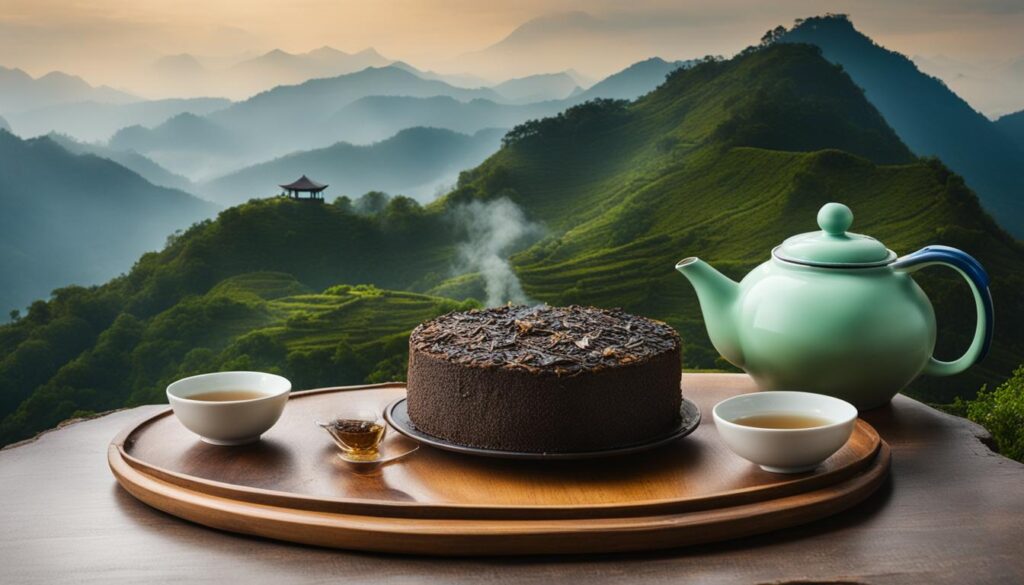
Join us in the next section as we delve into the world of purple tea, a relatively new variety that is gaining recognition for its unique qualities and health benefits.
Conclusion
Tea, oh tea! What a delightful and educational journey it has been exploring the different types of this beloved beverage. From the robust and caffeine-packed black tea to the light and refreshing green tea, each type offers its own unique flavor and character. But let’s not forget about the delicate and minimally processed white tea, or the partially oxidized oolong tea that falls between black and green. And how can we overlook the aged and partially fermented pu-erh tea, or the relatively new variety of purple tea?
Just like the diverse origins of these teas, ranging from China to India and even beyond, the world of tea is truly a global tapestry of flavors. Each cup tells a story, a tale of tradition, craftsmanship, and the rich history of this ancient beverage. Whether you’re sipping a robust morning cup or indulging in a soothing evening brew, tea has a way of bringing people together, comforting the soul, and awakening the senses.
So, next time you reach for that teapot or tea bag, take a moment to appreciate the journey that led to your cup. From the humble Camellia sinensis plant to the skilled hands that pluck, process, and infuse love into every leaf, tea is so much more than a simple beverage. It’s a testament to the beauty of nature, the artistry of the tea master, and the joy that can be found in the simplest of pleasures. Cheers to the wonderful world of tea!
FAQ
What are the primary types of tea?
The primary types of tea are black tea, green tea, white tea, oolong tea, pu-erh tea, purple tea, and herbal infusions.
Where does tea come from?
All types of tea originate from the same plant, Camellia sinensis, which has two varietals – camellia sinensis var. sinensis and camellia sinensis var. assamica.
How are the different types of tea made?
Each type of tea has unique characteristics determined by its harvesting and processing methods. Black tea is fully oxidized, green tea is steamed or pan-fired to halt oxidation, white tea is minimally processed and air-dried, oolong tea is partially oxidized, pu-erh tea is aged and partially fermented, purple tea is a relatively new variety, and herbal infusions are made from herbs, flowers, and grains.
What is the difference between black tea and green tea?
Black tea is robust and high in caffeine, while green tea is light and low in caffeine.
Which countries are known for producing black tea?
Black tea is primarily produced in China and India. Indian black teas are stronger and used in breakfast blends, while Chinese black teas are milder and enjoyed on their own.
Which countries are known for producing green tea?
Green tea is primarily produced in China and Japan. Japanese green teas are steamed and have a savory flavor, while Chinese green teas are pan-fired and have a mellow flavor.
What are the characteristics of white tea?
White tea is delicate and minimally processed, resulting in a light body and mild flavor. It is primarily produced in China, especially in the Fujian province.
How is oolong tea different from black and green teas?
Oolong tea is a partially oxidized tea that falls between black and green teas in terms of oxidation. It can range from lightly oxidized to almost fully oxidized, resulting in a range of flavors.
Where is pu-erh tea primarily produced?
Pu-erh tea originated in Yunnan province, China, and is still primarily produced in that region. It is an aged and partially fermented tea known for its rich and earthy flavor.
What is the difference between pu-erh tea and herbal infusions?
Pu-erh tea is made from the leaves of the Camellia sinensis plant, while herbal infusions are made from herbs, flowers, and grains.
Can you summarize the types of tea and their origins?
Tea comes in various types, including black, green, white, oolong, pu-erh, purple, and herbal infusions. Each type has distinct characteristics and is produced in different regions of the world.



